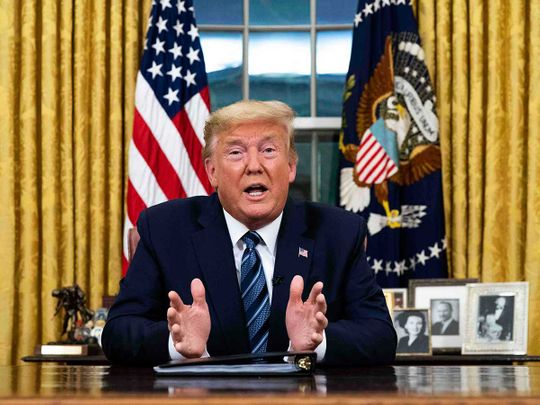
Here’s Donald J. Trump, former president of the United States, making headline news — again — after he warned the nation that the projected indictment against him by the Manhattan US district attorney, rendering him the first president in American history to be charged with a crime, would result in “potential death and destruction”.
And here is the following day, again garnering headlines, at a campaign rally in Wano, Texas — one that drew thousands of his devoted, diehard supporters, who had streamed into the small town halfway along the I-35 between Dallas and Austin, wearing their red MAGA hats and raising “Trump or Death” flags on their Jeep Wranglers — where he fulminated about how the unguarded southern borders allowed hordes of illegal immigrants to slip through into the US with impressive ease, how the 2020 election was stolen from him, and how, absent his return to the White House in 2024, the US is sure to go right to hell in a handbasket.
A constant in America’s imagination
Donald Trump, now 76, has not let up since he left office soon after his Jan. 6 speech on the Mall in which he urged a large crowd of his fans to march on the Capitol. But nor has public interest in his escapades shown signs of letting up either. He remains a constant in America’s imagination and a figure larger than life in American political culture.
Unlike former presidents, who often, much like good soldiers, fade away, into the background, giving the odd lecture at the odd think tank, working on their memoirs and helping with the founding of their presidential libraries, Trump has remained in the public eye, eliciting almost daily media attention.
Surely, no other such president has triggered such sustained interest and continued, in his post-White House years, to mesmerise Americans and to acquire, as it were, permanent habitat in their national consciousness.
How to explain that an addiction — and I’m convinced that is the right word here — to this utterly undistinguished man, often given to incoherent harangues, by an overwhelmingly literate population of a country that, since the beginning of the second half of the 29th century, has considered itself, and been considered by others, as leader of the free world and the global pacesetter in technology, science, literature and the arts?
In order to understand why Americans, for example, see the issue of whether or not Donald had a fling with Stormy Daniels seemingly more important than, say, that every year 65,000 Americans die of drug overdoses and that gun violence claims a life every 15 minutes, we have to understand that “Trump” is not the name of a former president but that of a defining political movement, an alluring movement named after its leader who founded it, like Marxism, Nasserism and Maoism.
We have to understand, in short, that American society is polarised. There is, on the one hand, Trumpism, represented by Americans who refuse to accept what to them is the painful fact that America today is a changing nation — indeed, one that has already changed — where four in 10 citizens identify as non-White — a truly painful fact to folks who, since the founding of the American Republic, had been lords of the manor.
Trump’s chaotic years
And there is, on the other hand, progressive, liberal and middle-of-the-road Americans who remember Trump’s chaotic years in office, a time when the chief executive in the Oval Office undermined the institutions of democratic government and fear the man’s return to power, given the fact that he today enjoys a commanding advantage in the primary field, a candine the size of whose rallies is the envy of every politician, both Republican and Democratic.
Since that day he descended the stairs of an escalator on June 16, 2016 to the basement of his eponymous New York Tower to announce his presidential run, Trump has remained the story.
And he remained the story because, though his unconventional behaviour would’ve sunk any president who had ever occupied the White House, Trump had been tapping into a vibrant, albeit reactionary movement in American society.
Virtually all Republicans on the Hill fear him or do not have the spine to challenge him on issues they know he’s wrong about. Indeed, for most Republican leaders to do so would effectively amount to political suicide.
A study conducted by The Equity Research Institute at the University of California recently found that 142 of the House’s 222 Republicans represent districts with low levels of racial diversity that are dominated by White voters who had no college degrees and whose concerns are more racial and cultural than political and economic — and these are the folks who feed on the inchoate energy of Trumpism.
Where does America go from here?
Washington Post columnist E.J. Dionne put it best in his column last week when wrote: “A substantial majority of the country would like to be done with Trump and the nastiness that he sows.
Many Republican leaders quietly agree, but their electorate and the nature of the places they represent push toward timidity. Until the incentives change or the party’s leaders discover the fortitude to defy them, we’re stuck in the world that Trump has created for us”.
And stuck with him in 2024 — in the White House till 2026?
Fawaz Turki is a noted journalist, academic and author based in Washington. He is the author of The Disinherited: Journal of a Palestinian Exile.












